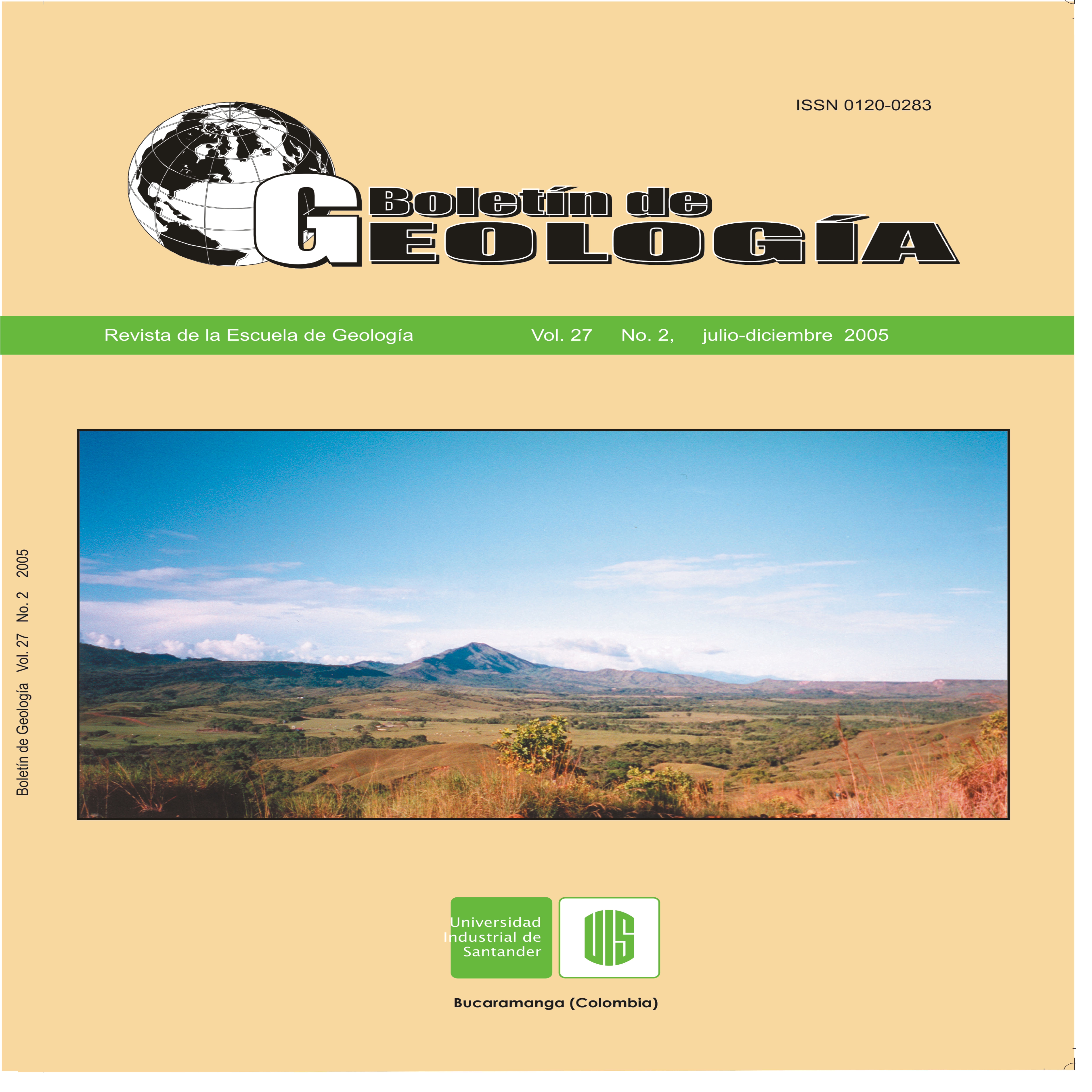CATION SUBSTITUTIONS GOVERNING THE CHEMISTRY OF AMPHIBOLE IN THE SILGARÁ FORMATION METABASITES AT THE SOUTHWESTERN SANTANDER MASSIF
Cómo citar
Resumen
Amphibole-bearing parageneses from the Silgará Formation metabasites at the southwestern Santander Massif record evidence of prograding metamorphism. Optical and microprobe analyses, together with thermobarometric estimates on these rocks, show that the main variation in Ca-amphibole is the simultaneous substitution of Al into the T1 site (AlIV) and Na+K into the A-site of the amphibole’s crystal structure. AlIV is strongly temperature dependant, and this dependancy masks any pressure effect. Changes in the chemical composition of Ca-amphibole grains are interpreted through coupled substitutions, and reactions with co-existing minerals during an increase in metamorphic conditions from greenschist to lower amphibolite facies, being favourable circumstances record not only the metamorphic facies reached by rocks but also the P-T conditions by which these were attained.
Keywords: amphibole, Silgará, metabasites, substitution, metamorphic conditions
Descargas
Referencias
Bence, A., and Albee, A. (1968). Empirical correctionfactors for the electron microanalysis of silicates andoxides. Journal of Geology, Vol. 76, pp. 382-403
Blundy, J., and Holland, T. (1990). Calcic Ca-amphiboleequilibria and a new Ca-amphibole plagioclasegeothermometer. Contributions to Mineralogy andPetrology, Vol. 104, pp. 208-224
Brown, E. (1977). The crossite content of Ca-amphiboleas a guide to pressure of metamorphism. Journal ofPetrology, Vol. 18, pp. 53-72
Castellanos, O. (1999). Estudio mineralógico y petrográficode la Formación Silgará en la Franja Pescadero-Aratoca(Santander). Tesis de Pregrado, Universidad Industrial deSantander, Bucaramanga (Colombia)
Deer, W.A., Howie, R.A., and Zussman, J. (1983) Rock-forming Minerals, Chain Silicates, Vol. 2, Wiley, NewYork, 379p
Dörr, W., Grösser, J., Rodriguez, G., and Kramm, U.(1995). Zircon U-Pb age of the Paramo Rico tonalite-granodiorite, Santander Massif (Cordillera Oriental,Colombia) and its geotectonic significance. Journal ofSouth American Earth Sciences, Vol. 8(2), pp.187-194
Ernst, W., and Liu, J. (1998). Experimental phase studyof Al- and Ti-contents of calcic Ca-amphibole in MORB– A semiquantitative thermobarometer. AmericanMineralogist, Vol. 83, pp. 952-969
Forero, A. (1990). The basement of the EasternCordillera, Colombia: An allochthonous terrane innorthwestern South America. Journal of South AmericanEarth Sciences, Vol. 3(23), pp. 141-151
García, C., y Castellanos O. (1998). Petrografía de laFormación Silgará en la Cordillera Oriental, Colombia. XCongreso Latinoamericano de Geología, Buenos Aires,Argentina, Memorias, Vol. 2, pp. 263-268
García, C., y Ríos, C. (1999). Metamorfismo ymetalogenia asociada del Macizo de Santander, CordilleraOriental, Colombia. Informe final Proyecto deInvestigación. Universidad Industrial de Santander-Colciencias, 191p
Gélvez, J., y Márquez, R. (2002). Caracterización texturaldel granate y de sus elementos de deformación asociados,y modelamiento de su historia de nucleación ycrecimiento en las rocas metapelíticas de la FormaciónSilgará en la región suroccidental del Macizo de Santander.Tesis de Pregrado, Universidad Industrial de Santander,Bucaramanga (Colombia)
Gilbert, M., Helz, R., Popp, R., and Spear, F. (1981).Experimental studies of amphibole stability. Rev. Mineral.,Vol. 9B, pp. 229-353
Goldsmith, R., Marvin, R., and Mehnert, H. (1971).Radiometric ages in the Santander Massif, easternCordillera, Colombian Andes. U.S. Geol. Survey Prof.Paper, Vol. 750-D, pp. D41-D49
Graham, C. (1974). Metabasite amphiboles of theScottish Dalradian. Contributions to Mineralogy andPetrology, Vol. 47, pp. 165-185.
Graham, C., and Powell, R. (1984). A garnet-hornblendegeothermometer: calibration, testing and application tothe Pelona Schist, Southern California. Journal ofMetamorphic Geology, Vol. 2, pp. 13-131
Hammarstrom, J., and Zen, E. (1992). Discussion ofBlundy and Holland’s (1990) “Calcic Ca-amphiboleequilibria and a new amphibole-plagioclasegeothermometer”. Contributions to Mineralogy andPetrology, Vol. 111, pp. 264-266
Hawthorne, F. (1983). Crystal chemistry of theamphiboles. Canadian Mineralogist, Vol. 21, pp. 174-481.Hey, M. (1954). A new review of the chlorites.Mineralogical Magazine, Vol. 25, pp. 277-292
Holland, T., and Blundy, J. (1994). Non-ideal interactionsin calcic amphiboles and their bearing on amphibole-plagioclase thermometry. Contributions to Mineralogy andPetrology, Vol. 116, pp. 433-447
Johnson, M., and Rutherford, M. (1989). Experimentalcalibration of the aluminum-in-hornblende gebarometerwith application to Long Valley Caldera (California)volcanic rocks. Geology, Vol. 17, pp. 837-841
Kawakatsu, K., and Yamaguchi, Y. (1987). Successivezoning of amphiboles during progressive oxidation in theDaito-Yakota granitic complex, San-in belt, southwestJapan. Geochimica et Cosmochimica Acta, Vol. 51, pp.535-540
Kohn, M., and Spear, F. (1989). Empirical calibration ofgeobarometers for the assemblagegarnet+hornblende+plagioclase+quartz. AmericanMineralogist, Vol. 74, pp. 77-84
